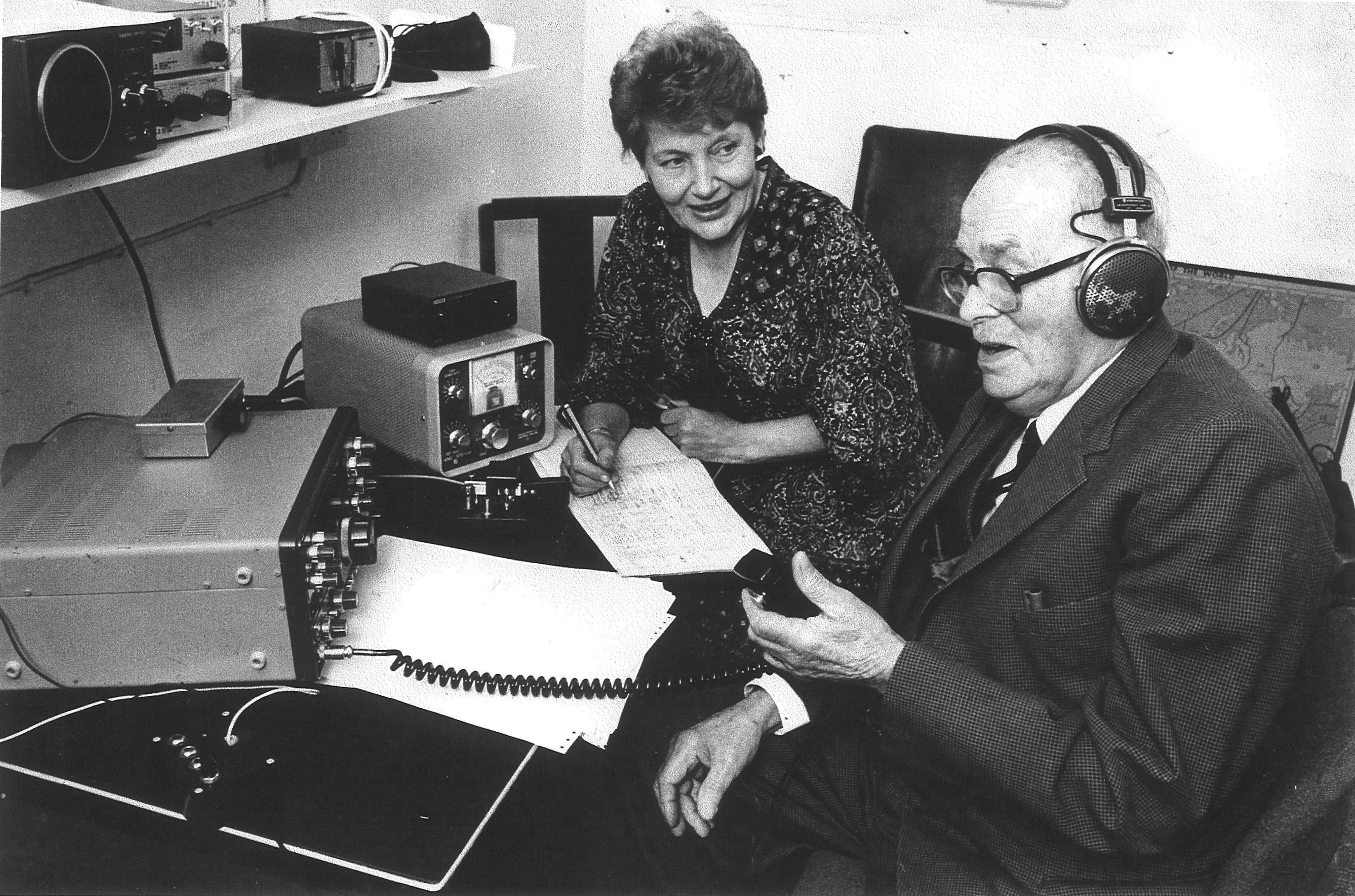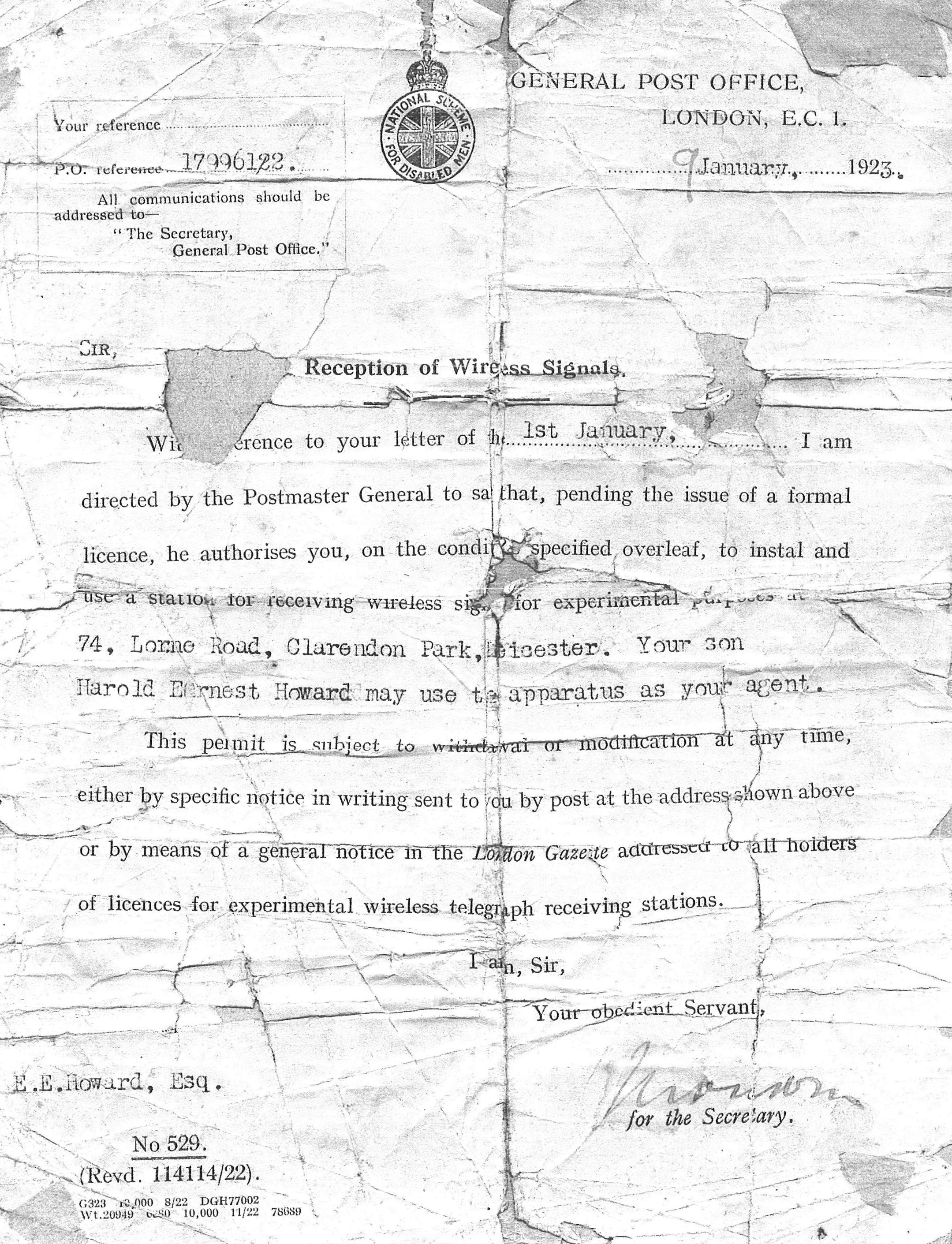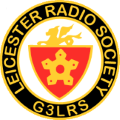Handwriten history written by Mr Harold E Howard describes his grandfather John Clark's early experiments in radio and electronics. This has been transcribed from a photocopy of a handwritten article so any mistakes are the fault of the transcriber and not the original author. Mr Howard was one of the earliest members of the Leicester Radio Society and is pictured below.

My grandfather, John Clark was born in Leicester in 1848. He used to lecture with the Rev Atkins on electrical phenomenon and magnetism at the old Vaughan College in Union St in 1877. It was in that year that a Mr J. T. Gent of Leicester first exhibited the electric telephone invented by Mr Grahame Bell in the Thorp St schoolrooms.
In April 1878, my grandfather constructed and installed a telephone linking his workshop to his house and this I understand was the first private operative telephone in Leicester.
It was such a novelty that the Doctor (Dr Blunt) who visited my grandmother following the birth of my own mother asked if he could speak to my grandmother from the workshop, and he did. That night he told a meeting of medical men that he believed he was the first Doctor to visit and speak to his patient without actually seeing her and this was made possible by the wonderful invention of the electrical telephone. In the year 1909 my grandfather built a wooden tower 40 feet high at Birstall. This was on high ground now known as Park Road, and owing to the large deposits of sand in the area it was jokingly referred to as the Birstall Lighthouse. In actual fact, the tower was erected to carry an aerial for a wireless transmitter and this was used in 1911 when a signal was transmitted from Birstall to a receiver at Knighton - a distance of approximately 10 miles.
In the year 1909 my grandfather built a wooden tower 40 feet high at Birstall. This was on high ground now known as Park Road, and owing to the large deposits of sand in the area it was jokingly referred to as the Birstall Lighthouse. In actual fact, the tower was erected to carry an aerial for a wireless transmitter and this was used in 1911 when a signal was transmitted from Birstall to a receiver at Knighton - a distance of approximately 10 miles.
The transmitter consisted of a coil of copper wire and a spark coil that made a large spark between the copper balls when the transmitting key was depressed. The battery was a large glass tank filled with a solution of Bichromate of Potash and Carbon + Copper plates. These plates had to be lifted out of the solution when the set was not in use. The operator of the transmitter had to stand on a rubber mat to prevent receiving a shock when using the key. The receiver consisted of an aerial and a large tuning coil connected to a Coherer - that is a glass tube filled with Iron filings. When the signal was receieved the Iron filings used to adhere to each other and they had to be seperated each time after use by a De-coherer, and this was like the hammer part of an electric bell that tapped on the glass tube (the Coherer) and prepared the Iron filings to receive the next Dot or Dash message from the transmitter. In reference to the copy of the Wireless Licence dated 1923. The Postmaster General at that time ruled that only persons over the age of 21 years were responsible enough to own a wireless receiver. So the licence had to be issued in my fathers name as I was only 20 at that time.
In reference to the copy of the Wireless Licence dated 1923. The Postmaster General at that time ruled that only persons over the age of 21 years were responsible enough to own a wireless receiver. So the licence had to be issued in my fathers name as I was only 20 at that time.
My receiver was all home made as this was before the time of the BBC & commercial sets were not available.
It had two valves as large as electric light bulbs and worked from 24 flash light cells and a 6 volt accumulator that had to be recharged each week from the local garage.
The condensors had to be hand cut from sheet aluminium and the coils of transformers all wound by hand this was a lengthy process. The aerial was 100 feet long + fixed on high poles in the garden.
The signals received in these early days came from Chelmsford, Manchester [2ZY] & Writtle [2MT] and the Hilversum in Holland [Nederlandse Seintoestellen Fabriek (NSF)] these transmitters were experimental types owned by large Electrical companies and the time of operation was about two hours each week day.
My son John Howard carried on with his interest of Radio and did service with the Royal Navy in the wireless section. On his return to civilian life he passed his exams and obtained a transmitting licence, took the call sign G3KQI. He is now a director of a local electronics company and has recently invented a electronic device to aid (shifts in resistors?). This has appeared on television and has been exported to many countries.






